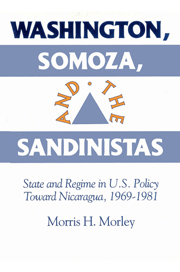Book contents
- Frontmatter
- Contents
- Acknowledgments
- 1 Introduction: Permanent and transitory interests in U.S. foreign policy
- 2 Washington and the Somoza dynasty: From consolidation to crisis of a client dictatorship
- 3 Supporting Somoza: Substance and symbol in American policy during the Nixon-Ford era
- 4 The Carter administration and Nicaragua: Human rights and the politics of accommodation
- 5 The Carter administration and Nicaragua: Mediation and the politics of frustration
- 6 Washington ruptures a historic relationship: Dumping the dictator to save the state
- 7 The Carter administration and revolutionary Nicaragua: Containing Sandinista power
- 8 Conclusion
- Bibliography
- Index
5 - The Carter administration and Nicaragua: Mediation and the politics of frustration
Published online by Cambridge University Press: 31 March 2010
- Frontmatter
- Contents
- Acknowledgments
- 1 Introduction: Permanent and transitory interests in U.S. foreign policy
- 2 Washington and the Somoza dynasty: From consolidation to crisis of a client dictatorship
- 3 Supporting Somoza: Substance and symbol in American policy during the Nixon-Ford era
- 4 The Carter administration and Nicaragua: Human rights and the politics of accommodation
- 5 The Carter administration and Nicaragua: Mediation and the politics of frustration
- 6 Washington ruptures a historic relationship: Dumping the dictator to save the state
- 7 The Carter administration and revolutionary Nicaragua: Containing Sandinista power
- 8 Conclusion
- Bibliography
- Index
Summary
Introduction
A proper conception of U.S. policy toward Somoza's Nicaragua must follow the multiple tracks that it pursues, as well as its capacity and willingness to shift track depending on the contextual situation, above all the scope and depth of the political-class struggle. Explanations for Washington's failure to distance itself from the regime during the 1960s and the first half of the 1970s must be sought in the continuing inability of the opposition to weaken Somoza's hold on political power and the regime's economic policies that favored foreign (primarily American) investment and banking interests. Through 1976 and 1977, a more complex U.S. policy approach emerged in response to the incremental growth of localized, relatively uncoordinated opposition to the dictatorship. Although supportive of the latter's crackdown on the FSLN and the political left, the State Department began to issue occasional public criticisms of National Guard “excesses” and Somoza's lack of tactical flexibility in refusing to talk with even his most conservative opponents. Simultaneously, the American Embassy in Managua expanded its links with the non-radical, anti-regime civilian leadership.
Despite two major opposition attempts to overthrow Somoza before the halfway point of the Carter administration, U.S. policy oscillated between limited pressures for reform and “business as usual.” On the one hand, it suspended military aid and encouraged Somoza to negotiate with, and make concessions to, the “acceptable face” of the opposition movement. On the other, it continued to voice optimism that such reforms could be achieved without rupturing the historic collaborative relationship.
- Type
- Chapter
- Information
- Washington, Somoza and the SandinistasStage and Regime in US Policy toward Nicaragua 1969–1981, pp. 120 - 171Publisher: Cambridge University PressPrint publication year: 1994



